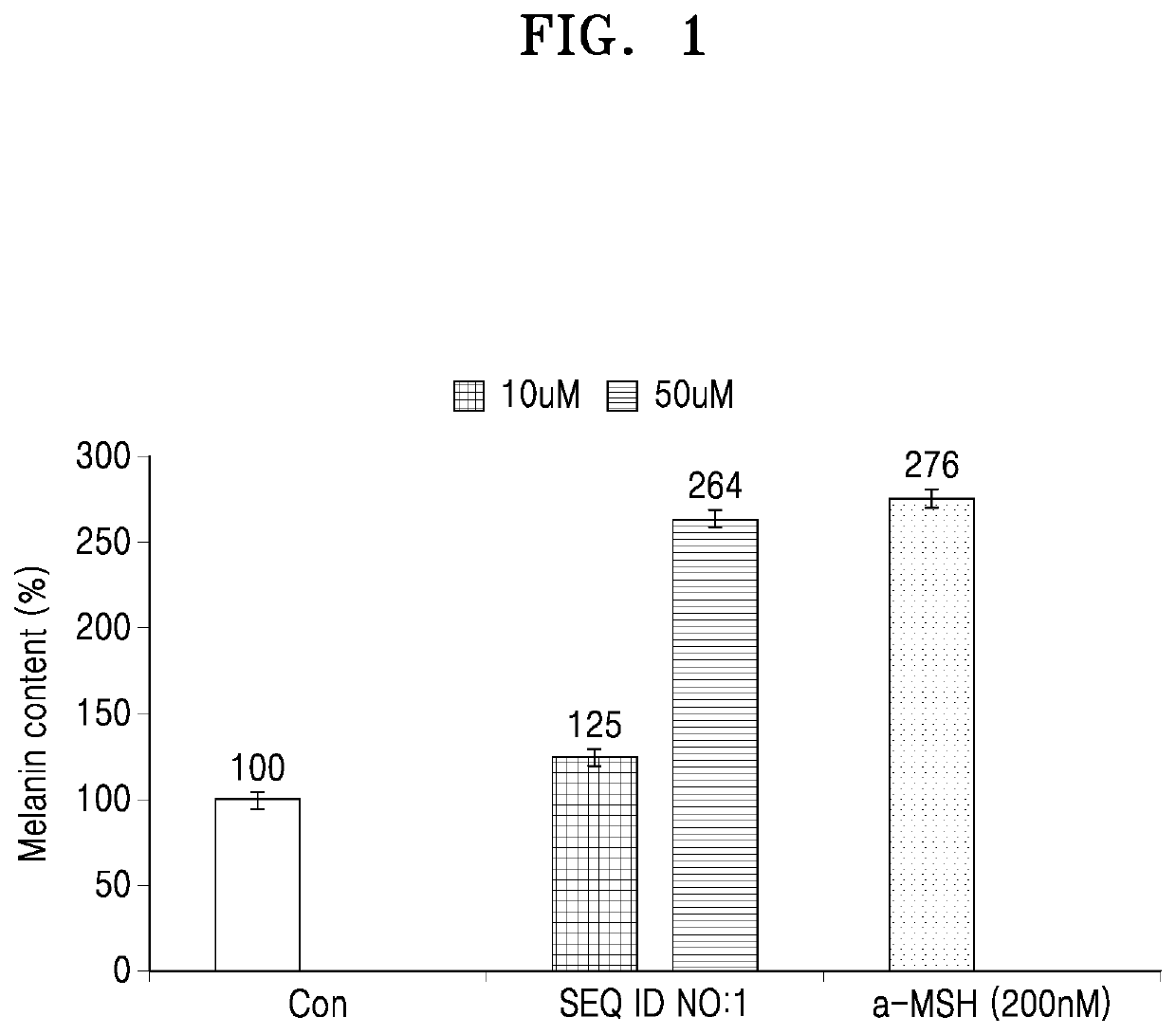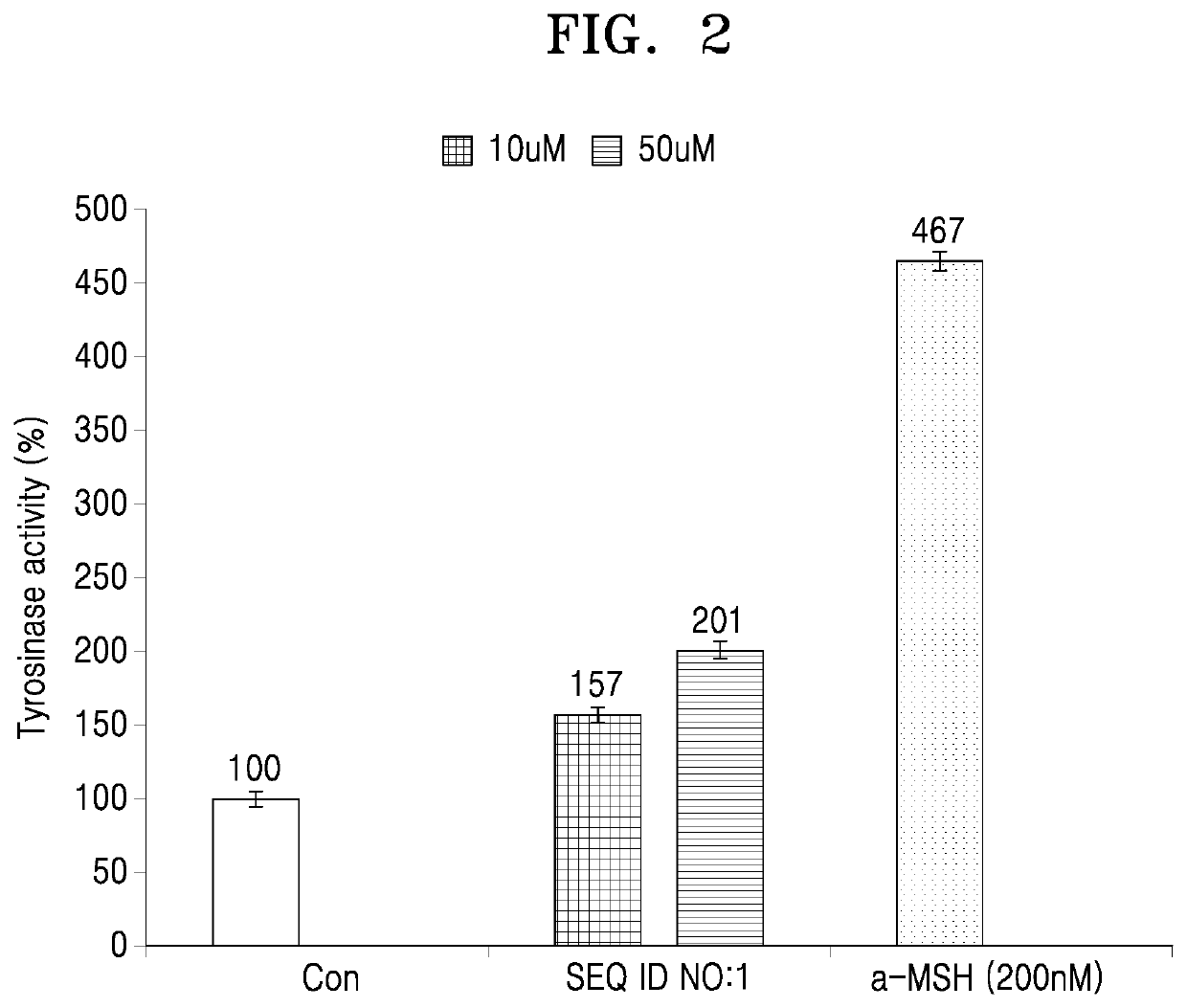Peptide showing melanogenesis promoting activity and use thereof
- Summary
- Abstract
- Description
- Claims
- Application Information
AI Technical Summary
Benefits of technology
Problems solved by technology
Method used
Image
Examples
example 1
esis Assay
[0079]After seeding melanocytes (B16F10 cell line) in 6-well plates at the density of 5×104 cells / well, the melanocytes were cultured in an incubator at a temperature of 37° C. for 24 hours, and the medium of each plate was removed and replaced with 2% serum-containing media, followed by treatment with the present peptide at different concentrations and then incubation of 72 hours.
[0080]Then, the culture medium was removed, and the cells were taken off and then transferred into 1.5-ml tubes, followed by centrifugation at 13,000 rpm for 3 minutes to remove the supernatant. Next, cell pellets were collected to observe melanin. 150 μl of 1 N NaOH was added to the cell pellets to lyse intracellular melanin at a temperature of 60° C. for 30 minutes. Thereafter, 100 μl of the supernatant obtained from the lysis was added into each well of 96-well plates, and the absorbance was measured at 450 nm, and the results are shown in FIGS. 1, 6, and 11 and Tables 2 and 4.
TABLE 2SEQ ID NO...
example 2
e Activity Assay
[0082]Melanoma cell line (B16F10) cells were cultured in 6-well culture plates for 24 hours, and treated with the peptide with different concentrations, followed by culture for 72 hours. The 6-well culture plates were loaded on ice and washed with cool PBS, and then 300 μl of 0.1 M sodium phosphate buffer (pH 6.8, lysis buffer) containing 1% Triton X-100 was added. The cells were collected in 1.5-ml tubes, and then cell membranes were disrupted by repeating five times rapid-freezing at −270° C. and thawing. After centrifugation at 15,000 rpm for 10 minutes, the supernatant was collected in other 1.5-mL tubes, and the protein of the samples was quantified. The samples were diluted to have the same protein concentration and then dispensed in every three wells in 96-well culture plates, and then 20 μl of 10 mM L-DOPA was added, followed by incubation at 37° C. for 1 hour The blank and positive control were as shown in Table 5.
TABLE 5SampleBlankPositive controlSample90 μ...
example 3
Melanogenesis-Related Genes
[0085]Melanocytes (B16F10 cell line) were seeded on 6-well culture plates at the density of 5×104 cells / well and incubated in an incubator for 24 hours. Then, the medium was replaced with 00, and the cells were treated with the peptides of the present invention with different concentrations and cultured for 72 hours. Next, after RNA extraction of cells and quantification, cDNA was synthesized by using the cDNA synthesis kit (Intron, Korea). Thereafter, as shown in Table 3, PCR was performed using specific primers for MITF, tyrosinase, and TRP1, which are factors involved in melanogenesis. Then, degrees of mRNA expression of the growth factors under each sample treatment conditions were compared by running the resultants on a 5% agarose gel, and the results are shown in FIGS. 3, 8, and 13.
TABLE 9SEQIDNO:Primer nameSequence listing (5′-3′)4MITF_FCCAGCCTGGCGATCATGTCAT5MITF_RGGTCTGGACAGGAGTTGCTG6tyrosinase_FGGCCAGCTTTCAGGCAGAGG7tyrosinase_RTGGTGCTTCATGGGCAAAAT...
PUM
| Property | Measurement | Unit |
|---|---|---|
| Volume | aaaaa | aaaaa |
| Volume | aaaaa | aaaaa |
| Volume | aaaaa | aaaaa |
Abstract
Description
Claims
Application Information
 Login to View More
Login to View More - R&D
- Intellectual Property
- Life Sciences
- Materials
- Tech Scout
- Unparalleled Data Quality
- Higher Quality Content
- 60% Fewer Hallucinations
Browse by: Latest US Patents, China's latest patents, Technical Efficacy Thesaurus, Application Domain, Technology Topic, Popular Technical Reports.
© 2025 PatSnap. All rights reserved.Legal|Privacy policy|Modern Slavery Act Transparency Statement|Sitemap|About US| Contact US: help@patsnap.com



